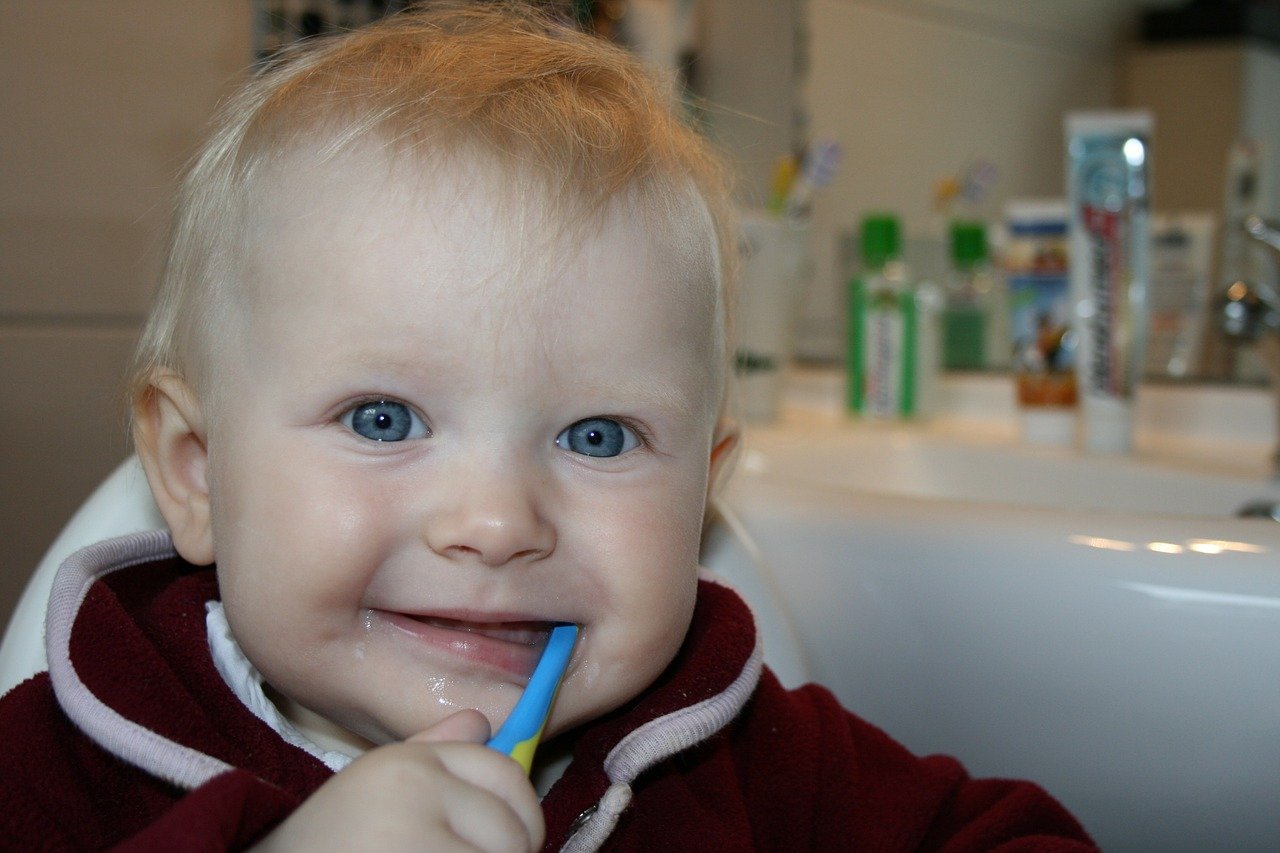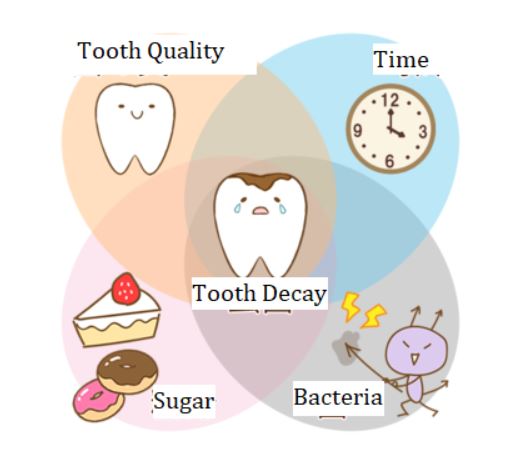
07 Oct The Causes and Prevention of Tooth Decay
Children’s Teeth and Mouth 1-3
After my previous post, Japan has suffered from the COVID-19 pandemic, as you know. Our daily life has changed greatly, and unfortunately, I was unable to complete this article as planned. But despite all these changes, I hope you and your children are living your day-to-day lives healthily.
For the past several months, our lifestyles have been adjusting to the new normal. Your baby may also be showing great change in growth and development. Being able to stand up, taking his/her first steps, or his/her teeth may have started to come in.
Although the world is facing a great societal change, I’d still like to continue sharing information about child-rearing.
Today’s topic is “The Causes and Prevention of Tooth Decay”
[The Causes and Prevention of Tooth Decay]
Part 1. The Causes of Tooth Decay
It was previously thought that tooth decay, also called cavities, was caused by a combination of three factors: teeth quality, decay-causing bacteria, and sugar. However, recently, a fourth factor, time, has also been shown to contribute to tooth decay. See the image below.

1.Teeth quality
When baby’s teeth begin to grow, the surface of the teeth are still soft enamel. Over time, the teeth mature in a process where calcium helps to harden the enamel. Therefore, maturation plays an important role in the prevention of tooth decay. When his/her teeth have congenital enamel defects (also known as congenital enamel hypoplasia), they may be more susceptible to decay.
2.Decay-causing bacteria
Decay-causing bacteria is the most important cause of cavities. These bacteria are often Streptococcus mutans (S. mutans) which adhere to the surface of the tooth by making a sticky substance from sugar. Sugar is a source of food for the bacteria. Then many other bacteria adhere, proliferate, and release acid that dissolves the teeth. This begins the formation of a cavity.
3.Sugar (sweets, juice, etc.)
Another cause for cavities is sugar, which is a food source for S. mutans. Everyday meals contain sugar which is important as an energy source for our bodies. However, consuming a lot of sugary foods, such as candies, gummies, and sweet juice, can increase the number of bacteria living on your teeth. This can ultimately lead to cause tooth decay. The saliva of a child who eats a lot of sugary foods and drinks becomes sticky. This makes it difficult to completely remove clumps of bacteria called plaque, even if his/her teeth are brushed properly. Consequently, the child is susceptible to tooth decay.
4.Time and saliva
As explained in the previous section, if teeth are exposed to sugar for a long time, bacteria proliferate forming a plaque. As a result, the plaque adheres to the surface of the teeth where cavities can begin to form. The saliva can neutralize the acid inside of the mouth after having a meal. However, eating at irregular times repeatedly can cause the saliva not to function properly, leaving acid inside the mouth and ultimately causing the teeth to dissolve or demineralize. Breast and formula milk themselves do not typically cause tooth-decay. However, because saliva production slows down during sleep, allowing a baby sleep while they are being fed can cause the surface of his/her teeth to dissolve.
Part 2) Prevention of tooth decay
To prevent the teeth from decaying, it is important to promote tooth quality, remove bacteria, limit sugar intake, and minimize exposure time.
1.Strengthen their teeth.
By applying fluoride to the surfaces of their teeth, Hydroxyapatite, a component of tooth enamel, can change to fluorapatite which helps prevent tooth decay. Since new primary teeth are susceptible to decay, and a new tooth erupts one after the other, routine fluoride treatments are necessary to prevent tooth decay.
Fluoride is a mineral contained naturally in many foods, such as vegetables, fruits, and fish. As there is not enough fluoride in tap water in Japan, applying fluoride is recommended in addition to consuming fluoride through foods.
As children are more prone to tooth decay, in addition to routine dental visits, you can add home-use topical fluoride toothpaste and mouthwash.
2.Remove dental plaque.
After meals, the plaque coats the surface of the tooth. The plaque not only contains food debris, but also bacteria that proliferate by eating the food debris. Brushing and flossing teeth is a basic technique which can remove plaque. Children’s toothbrushing has become a daily routine and unlike in the past, we rarely see children who do not brush their teeth. However, after brushing your teeth, the food and bacteria may still be present even if it does not appear to be. Therefore, depending on the age of the child, he/she may need special attention when brushing his/her teeth. For more information, it is advisable to ask your dentist. As explained in the previous section, the application of fluoride is also an effective way to reduce attachment of bacteria to the surface of a tooth in addition to tooth-brushing.
3.How to give your baby a snack.
Imagine that snacks are basically a part of a meal.
For adults, two or three meals a day and a small snack can be enough because their stomach is big enough to digest a large amount of food at once. However, when young children transition from being breastfed multiple times a day to eating solid food three times a day, they may not get enough nutrition because their stomachs are too small to absorb the daily nutrition requirements from only three meals. Therefore, feeding them one to two snacks are necessary. Keep in mind that many nutritious snack options are available such as potatoes, vegetables, fruits, small rice balls, or light meals. If snacks are something sweet, your baby may gain enough calories, but he/she may not receive enough nutrients and, as mentioned previously, sugary substance can cause tooth decay. Although sweets provide a sense of fullness, people become hungry very quickly because sugar cannot be stored in the stomach for a long time. This can result in children constantly wanting to eat something and becoming more susceptible to developing tooth decay (cavities). Moreover, research shows that sweets can also cause mood swings and restlessness in children.
Masaki Kudo D.M.D.


